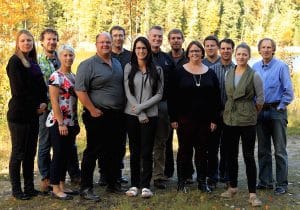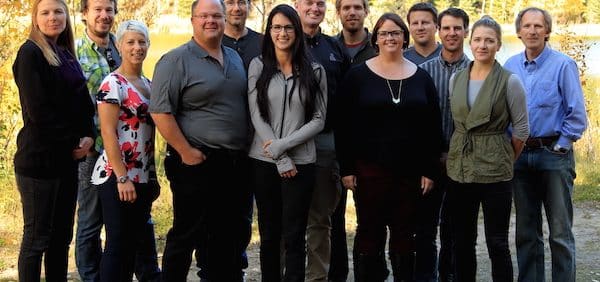The 11 Canola Council of Canada agronomy specialist have set individual priorities for their 2017 communications. Here is your chance to identify the agronomist for your region and see the focus areas for the whole team.

Autumn Barnes (on maternity leave), Alberta South barnesa@canolacouncil.org I’d like to see all canola growers set plant density targets. Record actual densities in their fields and plan to make improvements based on what they learned about the strengths and weaknesses of their operations. The Canola Council of Canada has been recommending plant densities of seven to 10 plants per square foot for well over a decade, but with rising seed costs, questions about improved vigour of herbicide tolerant hybrids and the lack of strong correlation between yield and plant density, some growers end up with fewer plants and successful harvests. Knowing this, growers should set plant density targets based on individual field conditions and their appetite for risk. In general, targeting a minimum of six plants per square foot is a pretty safe way for most growers in most situations to balance risk and profitability.
Angela Brackenreed, Eastern Manitoba brackenreeda@canolacouncil.org My priority is to convey associated costs and potential return on investment with agronomic practices. It is much simpler to deal with business management and production as unique disciplines. In practice, they can’t successfully be viewed in isolation. I hope to align my messaging with that reality.
Justine Cornelsen, Western Manitoba cornelsenj@canolacouncil.org Disease management needs to be looked at as a whole package deal. Genetic resistance is only one item in the package and needs to be used with other best management practices. Take a pair of snips to the field prior to harvest and clip some stems just above ground level. Growers may be surprised what they can find – even in a good-looking canola crop. Use your findings to help prepare future disease management strategies.
Ian Epp, Northwest Saskatchewan eppi@canolacouncil.org Given the difficult harvesting conditions in 2016, I expect volunteer canola to once again be a large problem. Not only is canola a highly competitive weed, it reduces the benefits of crop rotation by allowing canola pests (blackleg, sclerotinia, flea beetles etc.) to thrive in non-canola years. One of my 2017 goals is to help growers get a handle on volunteer canola. Tank mixing herbicides with glyphosate, targeting early effective in-crop control, creating stale seed-bed conditions in the fall, growing competitive crops with good volunteer canola herbicide options and rotating canola herbicide packages can all help to control volunteer canola. Another goal is to promote that good agronomy equals good weed control. While herbicides are the backbone of weed control plan, using good agronomic principles can reduce a complete reliance on herbicides and lower the risks associated with missed or poor spraying timing and the development of resistance.
Keith Gabert, Central Alberta South gabertk@canolacouncil.org I will encourage growers and agronomists to plan and schedule scouting and keep detailed notes to reference for future decision making. Any time a grower sprays for sclerotinia stem rot protection, I recommend a couple of unsprayed checks to see how the fungicide worked. I will continue to support researchers working to improve sclerotinia stem rot management, including weather modelling, spore detection technology and other tools to fine-tune our ability to manage the disease. We’ll consider revisions to the sclerotinina checklist, likely putting more weight on in-season moisture. I will also pay special attention to two insect pests: cabbage seedpod weevil and swede midge. Cabbage seedpod weevil continues to spread in Saskatchewan and northward in Alberta. Growers in these new areas will need to know about thresholds and management of this pest. Swede midge remains an unknown risk, particularly with the recent announcement of an unnamed midge discovered on the Prairies. Additional research and surveys will continue to determine the potential issues with these two related midge. Look for a spring release of a new CCC educational video on swede midge biology.
Clint Jurke, Agronomy Director jurkec@canolacouncil.org I want to find out if verticillium stripe has a yield penalty in canola. While the disease was recently notice in the Prairies, I think V. longisporum has been around for awhile. I am not sure if there is a yield penalty, but the work needs to be done to know for sure. Overall, I would also like to encourage better coordination between provincial disease surveys.
Dan Orchard, Central Alberta North orchardd@canolacouncil.org Clubroot, including management, prevention and communication, remains a priority for me. I want to help researchers and industry develop improved management techniques, including agronomy, soil remediation and education to combat clubroot. I strive to learn, explore and understand alternate clubroot management strategies outside resistance and rotation. Another focus of mine will be the continued success of canoLAB and canolaPALOOZA, filling in for Autumn as the organizer while she expands her family!
Nicole Philp, Southwest Saskatchewan philpn@canolacouncil.org I will encourage growers to look at matching varieties to fields or at least to specific farm needs. Look at traits that would benefit your field – disease tolerance or pod shatter, for example. Varieties with differing maturities can help to manage harvest timing. If growers want to try a new variety or other product before committing a whole field, doing a small trial can help them determine the benefits it can provide. Simple protocols for product testing (including foliar products, seed-applied products and variety trials) are available on the Ultimate Canola Challenge web page. I will also coordinate and promote the Canola Performance Trials, an independent variety testing program across Western Canada. It can give farmers insight into how different products perform under different conditions and in different years.
Gregory Sekulic, Peace (Alberta and B.C.) sekulicg@canolacouncil.org My priority is to promote this message: When considering pest control products, never ever “throw one in”. Use the economic threshold and risk management tools provided by research and extension agencies, including the Canola Council of Canada. Applications made below economic thresholds for insects, diseases and even weeds waste money, increase selection pressure for resistance, and increase the ecological footprint of crop production. It can also devastate populations of beneficial insects and natural enemies.
Shawn Senko, Northeast Saskatchewan senkos@canolacouncil.org Save your data! Yield monitors and other data-collecting tools mounted on farm machinery may have sim cards full of data. Save that data now, even if you don’t plan to use it this year, so that when work season starts and the monitor says “Memory card FULL” you don’t just delete it. You may want it some day. I will also remind farmers that when it comes to technology updates and investment in new machinery, know your numbers when it comes to things like seed survival and combine losses. How is the current drill influencing seed placement and seed survival, what new technology will improve results and will that is that improvement worth the investment? Can the current combine harvest reliably and with low losses, and how will a newer combine improve results? I will continue to remind growers that when spending money on technology, have an idea how you’ll get a return on that investment.
Warren Ward, Southeast Saskatchewan wardw@canolacouncil.org Phosphorus applications are still below removal rate for many canola growers. With soil sampling and a balanced fertility program, growers can target rates that reflect canola’s yield potential. Remember, the phosphorus a field requires may not all be safely applied in the seed row, so some may have to go in the blend banded outside the seed row. Keep in mind the 4Rs of Fertility – right source, right rate, right time and right place.
Find the region map as well as photos and phone numbers for all 11 agronomy specialists here.

